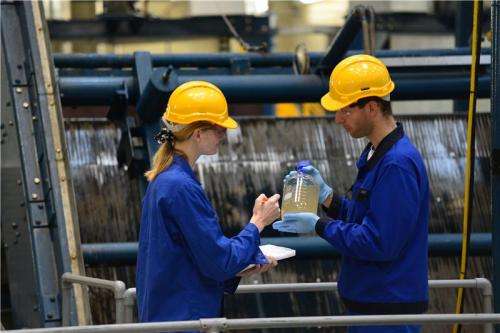Wastewater reveals drug consumption picture

In 2013, wastewater samples from European cities were tested for drug traces for the third time. Basel, Berne, Geneva, St. Gallen and Zurich were among the 42 cities which took part in the study. Over the course of a week, the wastewater of around 1.4 million people in Switzerland was tested for cocaine, amphetamine, crystal meth and ecstasy. The findings are published today in the peer-reviewed journal Addiction. Along with the Swiss Federal Institute of Aquatic Science and Technology Eawag, the work involved over 20 other research bodies and laboratories.
High levels of cocaine in Zurich
Zurich had the third highest cocaine use after Antwerp (Belgium) and Amsterdam (The Netherlands) during the week in which the study took place. Taking account of estimates with regard to purity and metabolism, around 1.6 kilogrammes of cocaine are used every day in Zurich. With the exception of Berne, the other Swiss cities are also above the European average, with Basel and Geneva in 9th and 10th place, St. Gallen in 12th place, and Berne at number 15. Whether it is that the cocaine being used in Switzerland has a comparatively high level of purity, or there is a higher use per head or more users than was previously estimated from other studies is yet unknown. In contrast, the figures for the designer drug crystal meth sit well below the average. The forerunners in this case are the Czech cities of Prague and Budweis, and Oslo, capital of Norway. (Detailed tables can be found in the aforementioned article.)
Ecstasy – primarily at weekends
The wastewater analysis enables the reconstruction of a snapshot mapping drug use over time. As one might expect, the use of the recreational drug ecstasy varies dramatically between normal workdays and the weekend (see graph). With cocaine, the difference between workdays and weekends is smaller, but nevertheless still statistically significant. This indicates that cocaine is also used during the week – and to some extent on a daily basis by addicts.
Unfortunately, the analysis figures for cannabis in Switzerland did not meet the stringent requirements for the participating laboratories. As Switzerland is known to have a high level of cannabis use, this data would have been particularly interesting. Topping the chart for cannabis are Novi Sad (Serbia), Amsterdam and Paris.
Long term: closer monitoring
From the standpoint of the first author of the study, engineer Christoph Ort from the Swiss Federal Institute of Aquatic Science and Technology Eawag, the "league table" of cities is not the central issue. For him, what is of far greater importance is the objective of obtaining comparative data much more quickly than is currently possible with national drug monitoring programmes. The small numbers of cases, for example, imply that these programmes cannot adequately indicate how many people use a drug in a particular region. When combined with data from other studies and statistics (e.g. surveys at parties, Addiction Monitoring in Switzerland, Global Drug Survey), the wastewater data, on the other hand, allows trends to be identified and confirmed more rapidly: the rise in ecstasy and cocaine levels found in the wastewater study from 2012 to 2013 is, for example, consistent with the substance analysis data of Saferparty.ch, run by the City of Zurich youth organisation, Streetwork. The rise is attributed to an increase in the purity of the cocaine and to higher-dose ecstasy pills. "Wastewater analyses offer the potential of improved quantification of substance use within a geographically defined area", affirms Alexander Bücheli from Safer Nightlife Switzerland. "It is still very difficult to draw conclusions as to the actual numbers of users, however, as this requires a series of assumptions to be made." It is hoped that future transdisciplinary projects will close this gap.
More information: The complete study is available online: www.eawag.ch/medien/bulletin/2 … itoring_in_press.pdf
















